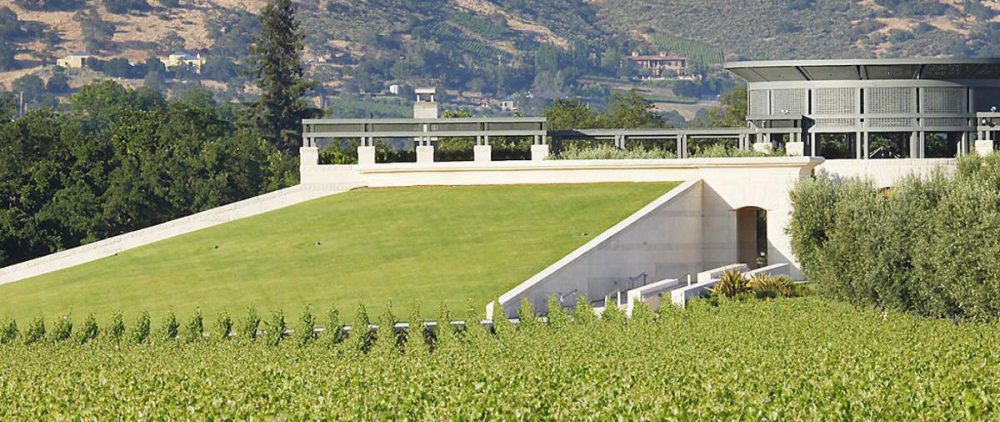We at Asia Bankers Club along with our partner, Cult Wines, are always striving to diversify the investment portfolios of our members, if you’d like to learn more about wine investment recommendations, its growth and ROI, please contact us now and we’d be happy to assist further.
Contents
Iconic Californian Producers
- Screaming Eagle
- Opus One
- Harlan Estate
- Ridge, Monte Bello Red
- Dominus
Iconic Producers of Emerging Wine Regions
- Vega Sicilia Unico – Spain
- Almaviva – Chile
- Penfolds, Grange – Australia
Tier One Producers of Emerging Wine Regions
- Mondavi & Chadwick, Sena – Chile
- Pingus – Spain
- Henschke, Hill of Grace – Australia
Rising Stars of US and Emerging Wine Regions
- Continuum, Propriety Red – US
Clos Apalta – Chile
Iconic California Producers
Featured
- Screaming Eagle
- Opus One
- Harlan Estate
- Ridge, Monte Bello Red
- Dominus
Screaming Eagle
If any wine exemplifies the California cult wine phenomenon, it’s Screaming Eagle, a wine brand synonymous with consistent, near-perfect critic scores, high prices, tremendous demand and, of course, short supply. As it stands, it is the most expensive American wine however the most critically acclaimed, the lack of availability in the market is astonishing. All 800 cases produced annually go to the lucky recipients at the top of a long queue of subscribers. It is nearly impossible to secure older vintages and is the most globally sought-after U.S wine.
The 57-acre vineyard was purchased by original owner, founder and former real estate agent Jean Phillips, in 1986. At the time, the estate was planted with a mix of varieties, most of which Phillips sold to other Napa wineries – but not all. One single acre, home to around 80 vines of Cabernet Sauvignon, piqued her interest, and she sought the opinions of Robert Mondavi’s employees on the commercial potential of a wine made from these vines.
‘Potential’, it seems, was something of an understatement: the 1992 vintage, released in 1995, received a 99-point score from Parker. At the time Phillips sold this vintage for $125 per bottle, and even then it was regarded as the most expensive wine produced in California! As the positive reviews flooded in and further fantastic vintages were produced, prices escalated, and vintages continued to sell out.
In 2006, Phillips sold the estate to Charles Banks and Stanley Kroenke after they allegedly made her an offer she couldn’t refuse. The sale is rumoured to have cost around $30m, but many speculate the figure was even higher. Three years later, Banks left to pursue other viniculture challenges, leaving Kroenke as the sole proprietor.
Market Performance
- Best performing 2003 vintage returned +109.8%
- Average 5-year performance across vintage since 2000 +74%
- Average WA scores of recent 10 vintages – 98 points
- 2007, 2010, 2015 and 2016 are awarded 100 points by Wine Advocate
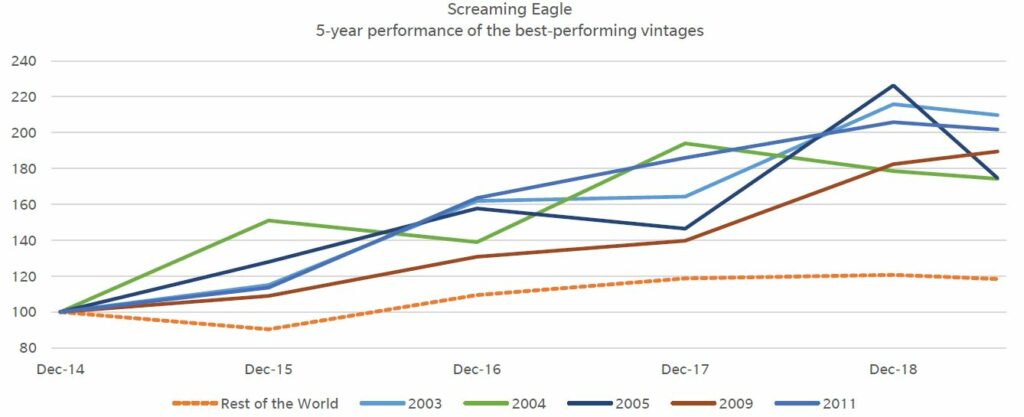

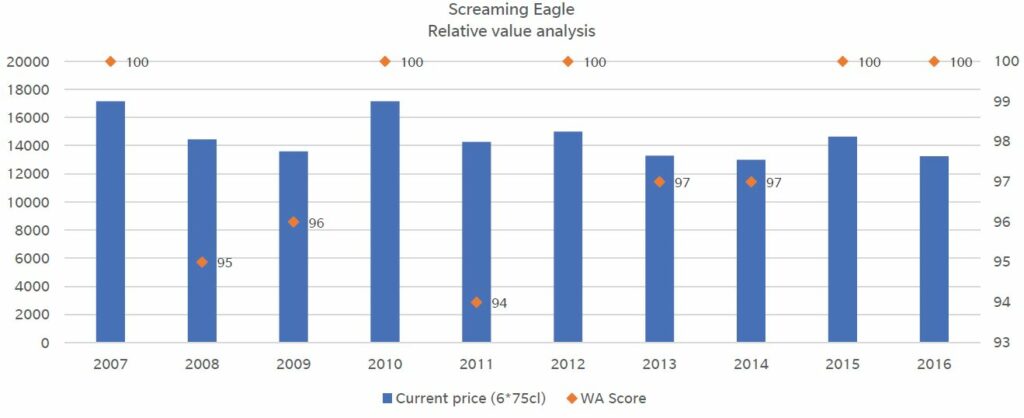

Opus One
Founded in 1979 in Napa Valley, Opus One is the joint venture of Robert Mondavi and Baron Philippe de Rothschild. 1984 saw the initial release of first two vintages, 1979 & 1980 and for a while they were the most expensive US wines on the market. Fast forward to today, it has now become one of the top-selling, high-end branded Californian Cabernet Sauvignon wines. Less exuberant than many Napa’s, it has a fruit-forward style and has more in common with Bordeaux wines – aged in French oak barrels for close to 20 months. Back in 2012, Opus One opened a sales and distribution office in Bordeaux and this strategy has proven extremely successful in developing the global brand. In particular the wine has developed a stronger following in the Far East than almost any other Californian wine, with Hong Kong and Japan having taken a keen interest.
After an enviable streak of vintages, Opus One has gone a long way to cementing itself as the flag bearer for Napa and now sits amongst the elite wines of the world in terms of quality and global acclaim. From a price perspective, however, it remains a value buy within the company of the First Growths of Bordeaux and leading Burgundy. The team at Opus lead by Michael Silacci is regarded as the most talented in Napa, and a string of high-scoring recent vintages have only further cemented Opus’ position as a US power brand and global icon in the market.
Market Performance
- Best performing 2005 vintage returned + 122%
- Average 2-year performance across vintage since 2000 +65%
- Average WA scores of recent 10 vintages – 96 points
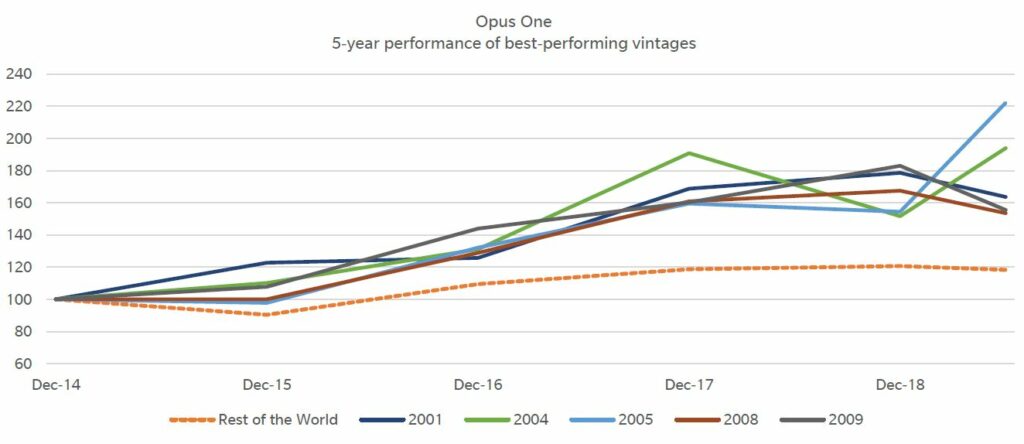

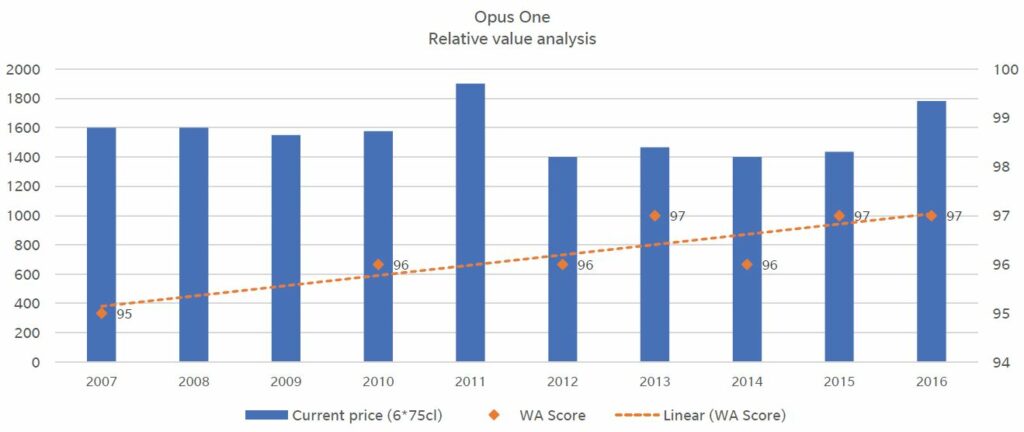

Harlan Estate
Described in Vanity Fair as ‘The Ultimate Cult Winery’, Harlan Estate has positioned itself through both superlative quality and shrewd branding as one of California’s most sought-after wines. Like most of the top winemakers in Napa, Harlan Estate owes a degree of its success to Robert Mondavi, as it was during a trip to Bordeaux with the great man that Bill Harlan settled on the idea of creating ‘California’s First Growth’. A shrewd real estate developer, Bill purchased the run down ‘Meadowood’ Country Club, turning it into one of the best hotels in Napa, as well as planting what would grow into this famous vineyard.
Beginning in 1984, Bill put down just 6 acres of vines, which he would steadily grow into a 36-acre plot producing between 1,200-2,000 cases per vintage. The topography of Harlan Estate is fairly unique – with multi-faceted slopes in some places reaching over 1,200 ft above sea level.
This variation inevitably contributes to the unique character of the wine and provides a degree of freshness not seen in many Napa Cabernets. The end-product, as you’d expect, is hugely expensive (upwards of $500 per bottle) and distributed mainly to a direct mailing list of clients.
Harlan, over its short life, has won a host of labels and accolades. Labelled by Jancis Robinson as one of the ‘greatest wines of the 20th century’ and awarded no fewer than eight perfect 100-point scores by Robert Parker’s Wine Advocate. It remains at the apogee of wine from the golden state and has every reason to rise in value, if you are fortunate enough to be able to purchase it.
Market Performance
- Best performing 2007 vintage returned + 75%
- Average 5-year performance across vintage since 2000 + 49%
- Average WA scores of recent 10 vintages – 98 points
- 2007, 2013 and 2015 are awarded 100 points by Wine Advocate
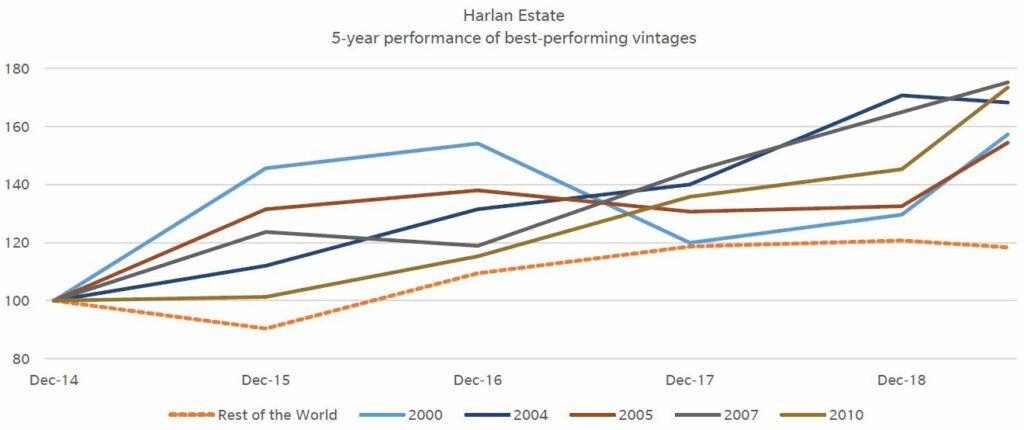

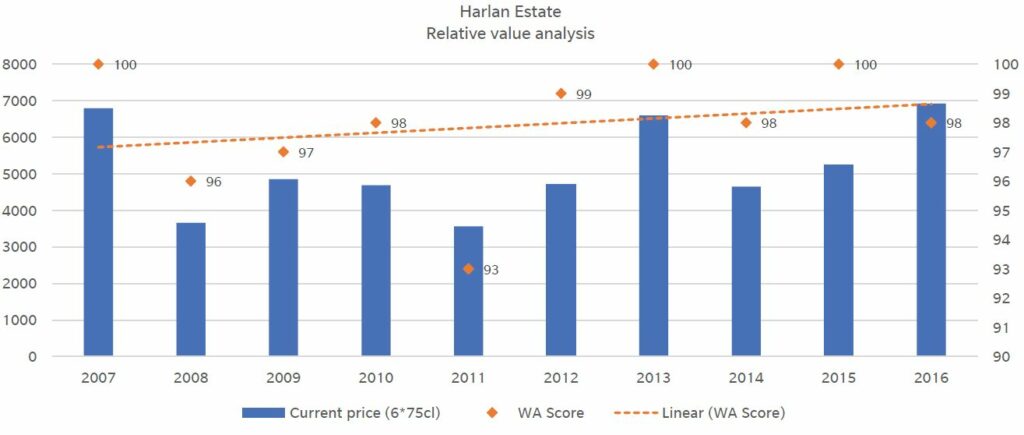

Ridge, Monte Bello Red
The history of wine making in California is perceived as being quite recent, with it really hitting international markets in the last 30 years. However, Italian immigrants planted vineyards in the Golden State as far back as the 1800s, with a few of these ancient vines still surviving today. One such parcel of these ancient vines is used to create Ridge’s Monte Bello Cabernet Sauvignon. One of the wines involved in the notorious ‘Judgement of Paris’, Monte Bello took fifth place against 9 of California and France’s top Bordeaux blends. The wine is synonymous with Paul Draper, who has produced 47 vintages for the estate, and to whom the above quote is attributed- having recently stepped down as CEO and head winemaker, he now occupies the position of Chairman of the Board, continuing to steer Ridge toward success. This success has come with inevitable accolades, most noteworthily Eric Asimov labelling it America’s greatest Cabernet in the New York Times and, outside of the Montebello, one of Draper’s Zinfandel’s being served in The White House at the last state dinner of the Obama Administration.
A wine that has more 100-point scores to its name than Chateau Margaux or Lafite, with the rising global profile of the California industry, Ridge still represents exceptional value for money when placed against its rivals from both home and France- with only 3,000 cases produced per year, it will be at the forefront of the west coast revolution.
“This profound Monte Bello will begin to blossom as it reaches age ten and should prove practically immortal.”
William Kelley, Monte Bello 2013 – 100 points
Market Performance
- Best performing 2002 vintage returned + 94%
- Average 5-year performance across vintage since 2000 + 54%
- Average WA scores of recent 10 vintages – 96 points
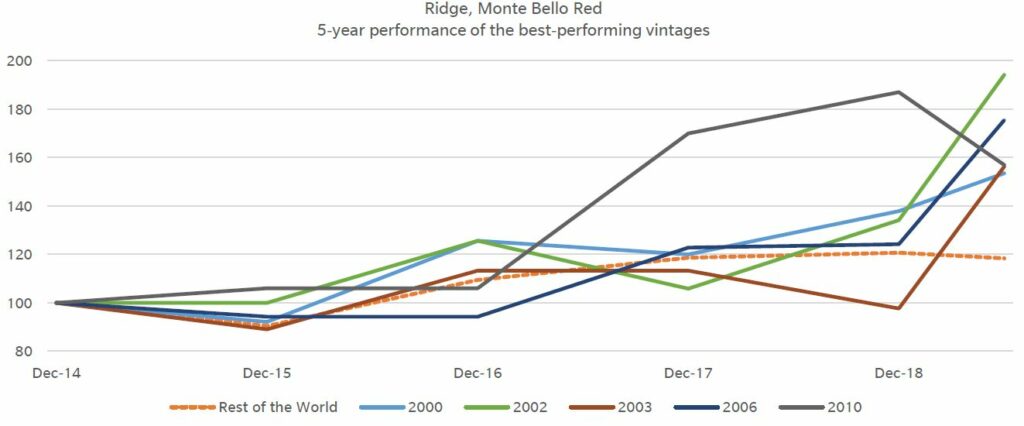

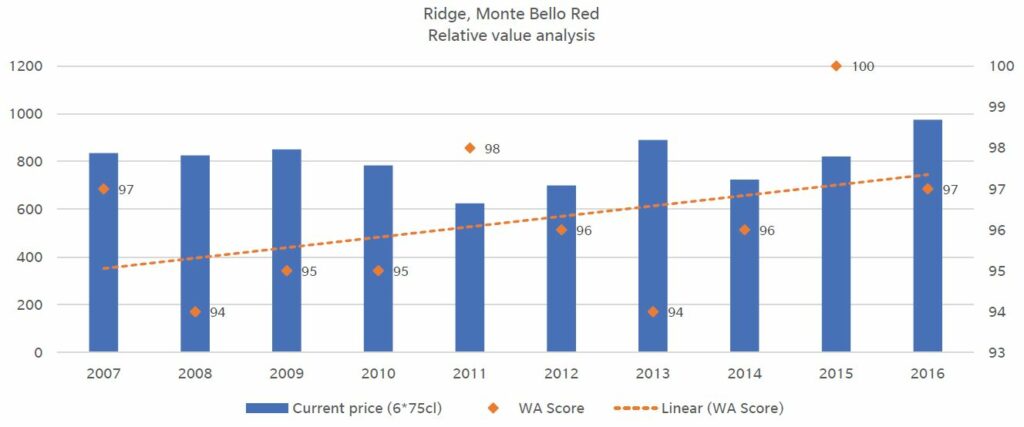

Dominus
In order to tell the story of Dominus you must first tell the story of Christian Moueix, the estates founder and famed winemaker. Moueix originated from Libourne, France. As the son of a successful Bordeaux wine merchant, he was born into the wine industry and took his inherited passion into his university studies at the University of California, studying oenology in the late 60’s. It was during his time at university that Moueix fell in love with Californian wine. However, it would be a number of years before he would return to form the partnership that created Dominus.
Moueix has been closely associated with a number of famous Pomerol vineyards during his career, La Fleur Petrus, Hosanna, Trotanoy and most notably Directorship of Chateau Petrus for 40 years up to 2008, a time in which the estate ascended to the very pinnacle of the world of fine wine, where it remains.
Moueix became sole owner of Dominus back in 1995 and can boast that he’s taken critic appraisal and scores from the 80s through the low 90s to the high 90s and subsequently to the wine’s first ever 100 points from the influential Robert Parker, with the 2010 vintage. Since 2010, three more vintages have received 100 points from the wine Advocate in the 2013, 2015 and most recent release the 2016.
Dominus Estate how been one of the top tier producers in the Napa Valley for almost two decades but has managed to set itself apart from many others by developing a stronger global brand and importantly nurturing an active market outside of the States. This can be largely be credited to Moueix as a businessman who has achieved this before to stratospheric success in Chateau Petrus. With this in mind, we can see no reason why Moueix cannot make considerable headway in replicating Petrus’s success in Dominus over the next decade.
Performance of Dominus is competitive with a stable and positive curve over the last 5 years showing a 69.5% price increase across all vintages. Production is low at approximately 6,500 cases per vintage. A 12x75cl case will cost approximately £2,700, vintage dependant. With low production and a strong brand globally, prices are expected to continue to rise as Californian wines continue to command a larger share of secondary market trading. Dominus being a qualitative frontrunner is leading the charge.
Market Performance
- Best performing 2000 vintage returned + 96%
- Average 5-year performance across vintage since 2000 + 54%
- Average WA scores of recent 10 vintages – 98 points
- 2010, 2013, 2015 and 2016 are awarded 100 points by Wine Advocate
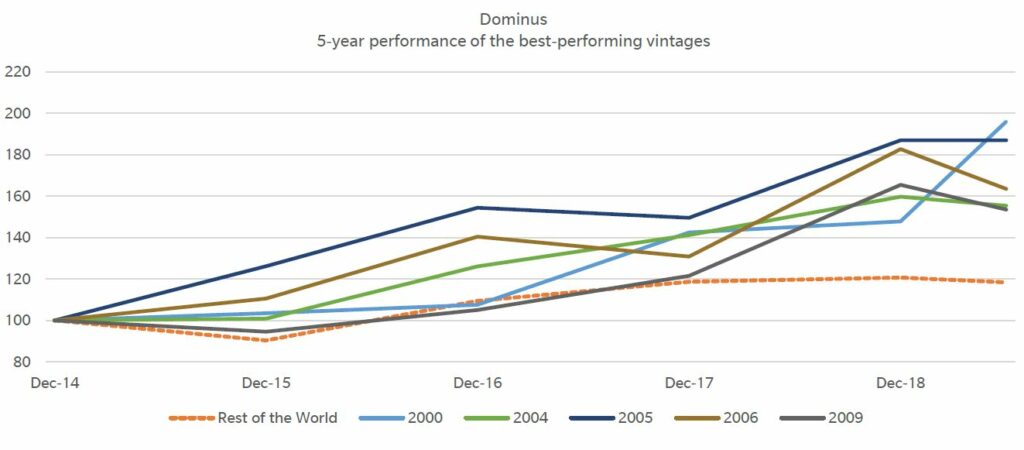

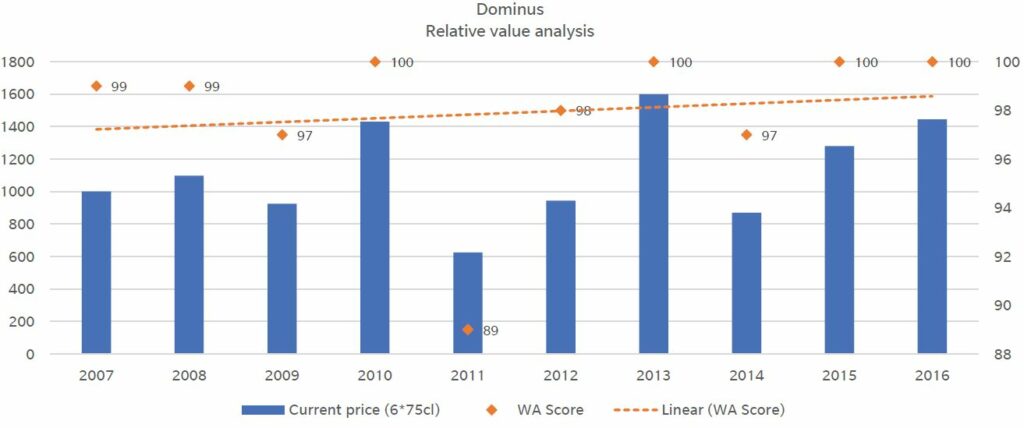

Iconic Producers of Emerging Wing Regions
Featured
- Vega Sicilia Unico – Spain
- Almaviva – Chile
- Penfolds, Grange – Australia
Vega Sicilia Unico
In 1848 a Basque landowner named Toribio Lecanda bought a 2,000-hectare estate in northern Spain used for agriculture and cattle farming. Sixteen years later his son Eloy planted various grapes from Bordeaux, including Cabernet Sauvignon, Malbec and Merlot, in order to make brandy. In 1876 he became the supplier to the Royal family. The estate had several owners over the next few decades until it was acquired by the Herrero family, who took on Domingo Garramiola Txomin as winemaker. Domingo used what were then considered revolutionary Bordeaux techniques for making wine, and he renewed the ageing casks and cleaned the wine presses. In 1915, Vega Sicilia and another wine, Valbuena, were born. Originally the wines were only distributed among the upper classes and the aristocracy, but at the 1929 World Fair in Barcelona they received public recognition, with awards to the 1917 and 1918 vintages.
The only Spanish wine to be included in the Liv-ex 1000 index ‘rest of the world 50’ index, Unico isn’t only regarded as Spain’s premier wine, but it is considered one of the finest clarets produced anywhere globally. Based in Ribero del Duero, this bodega blends traditional Bordeaux varietals with Spain’s flagship grape – Tempranillo, and will then age the wine in a blend of old and new oak barrels for anywhere from 6-16 years before bottling.
With production levels of less than 6000 cases per annum and an average Wine Advocate score across the last 10 vintages of 96 points, Vega has fast become crucial component to any well diversified wine portfolio. The 2004 vintage is widely regarded as one of the finest recent achievements, scored 97 by the wine advocate ‘The 2004 Unico is truly spectacular, in line with the 1970 and 1994’.
Market Performance
- Best performing 1991 vintage returned + 73%
- Average 5-year performance across vintage since 1989 + 30%
- Average WA scores of recent 10 vintages – 96 points
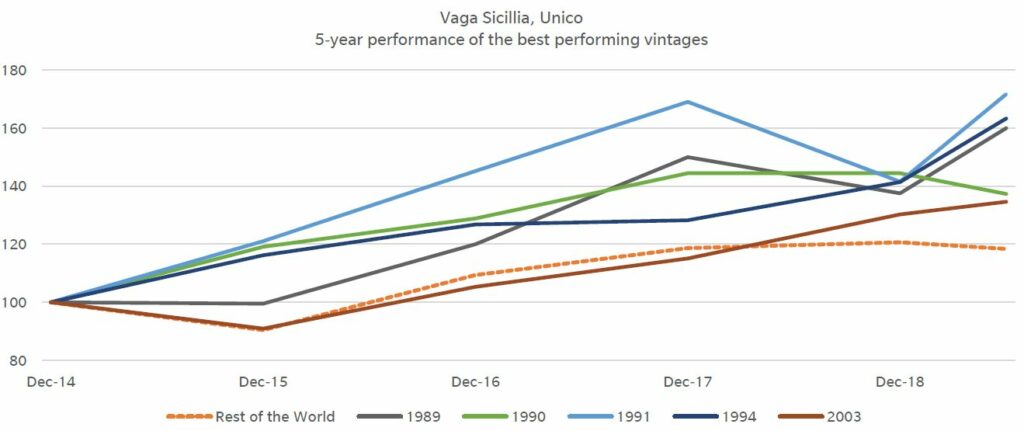

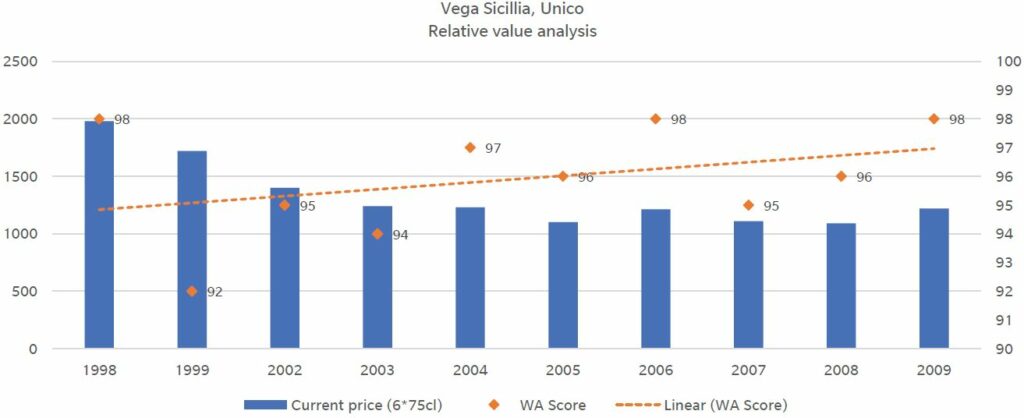

Almaviva
Almaviva is a collaboration of two great winemaking dynasties – Concha y Toro of Chile and Baron Philippe de Rothschild of Château Mouton Rothschild (Bordeaux). Their sole aim was to produce a wine of Bordeaux Grand Cru Classes quality in Chile and few would argue against this being achieved over the last two decades. The pedigree at Almaviva filters down to the vineyards with head winemaker, Patrick Leon (winemaker at Mouton and Opus One in Napa) at the helm.
The winery situated in Maipo Valley is state of the art with a revolutionary irrigation system means each vine is proved the exact amount of water it needs. This precise and meticulous nature led to wine critic, James Suckling awarded the 2015 Almaviva 100 points, the second only ever wine to achieve this at the time. He went one step further and declared it his 2015 wine of the year.
Production levels sit at around 15,000 cases per annum, up from 3000 cases for the inaugural vintage in 1996. To complement the Cabernet Sauvignon (~65%) they blend with Carmenere, Cabernet Franc, Petit Verdot and a small proportion of merlot. The wine spends 16 months in new French oak.
Almaviva is undoubtably a brand on the rise with prices increasing year on year. Pricing data for older vintages is unreliable given the lack of availability however the average price per case (12x75cl) since 2010 is £1,238 with an average increase in value of 38.83%.
Market Performance
- Best performing 2003 vintage returned + 117%
- Average 5-year performance across vintage since 2000 + 71%
- Average WA scores of recent 10 vintages – 93 points
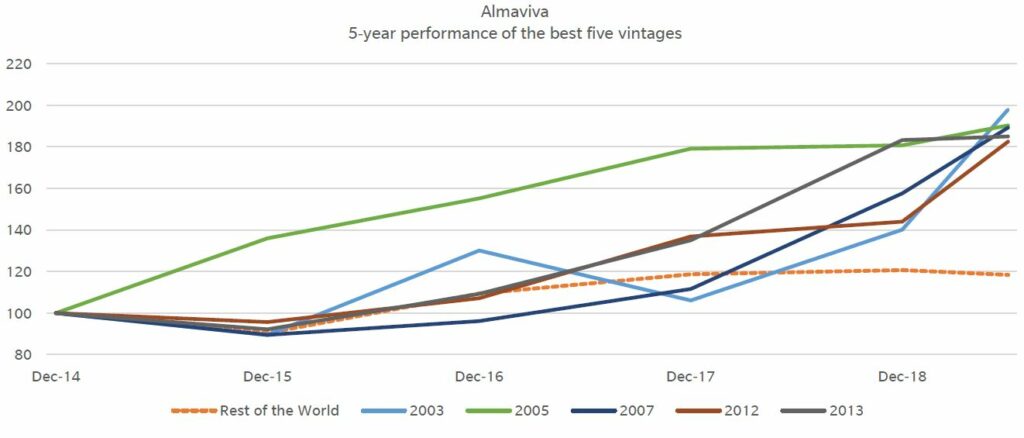

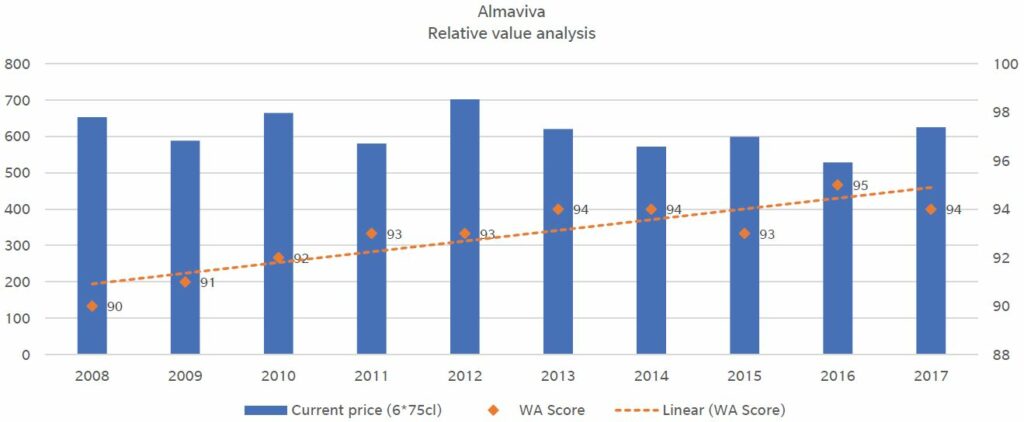

Penfolds, Grange
Founded in 1844, Penfolds is a winery that is synonymous with Australia, and has since grown to represent the very pinnacle of the best wines the country has to offer. Legendary status does not come without hard work and brilliant wine making, so it’s a good thing that Peter Gago, chief winemaker, is at the helm. Twice the winner of winemaker of the year, Peter is not the only legend at Penfolds, as their 1955 vintage, was ranked by Wine Spectator as one of their 12 wines of the century – sitting alongside Petrus 1961 no less (average, £9,000 Per bottle).
There has never been a shortage of great people at Penfolds, with Max Schubert joining the company as a messenger boy in 1931, he was the chief winemaker by 1948, at the tender age of 33, he became Penfolds’ first chief winemaker. By 1950, Schubert was sent to Europe, to investigate the best of wine making in Spain & Portugal – but it was on a side trip to Bordeaux, where Schubert gained inspiration by the French cellared-style wines and dreamed to make ‘something different and lasting’ of his own.
Back in the warmer climes of Adelaide, Max went about looking for the perfect ‘raw material’ for his project – taking on Shiraz as the grape of choice. 1951 saw Schubert’s first experimental wine, combining traditional Australian techniques with inspiration from Europe, and precision wine making practices developed at Penfolds.
In 1957, Max was asked to show his efforts to top management in Sydney, with a smattering of wine identities and personal friends of the board. The wine was widely disliked – and he was forced to shut down the project. This spurred Max on. He created 3 vintages in secret, hiding them in the dark depths of the cellars (1957,1958,1959). Eventually, the Penfolds board ordered production of Grange to restart, in time for the 1960 vintage – since then, accolades, awards and international acknowledgment were bestowed upon them – including the 1990 vintage, named Wine
Spectator’s Red wine of the year in 1995.
It’s reputation as one of the world’s most celebrated wines continues to grow today, while the 2008 vintage achieved the perfect 100-point score by arguably the world’s two most influential wine publication, Robert Parkers Wine Advocate & Wine Spectator. The 2013 and 2015 have also been awarded the coveted 100 points.
Market Performance
- Best performing 1999 vintage returned + 53%
- Average 5-year performance across vintage since 1999 + 27%
- Average WA scores of recent 10 vintages – 98 points
- 2007, 2008 and 2013 received 100 points awarded by Wine Advocate
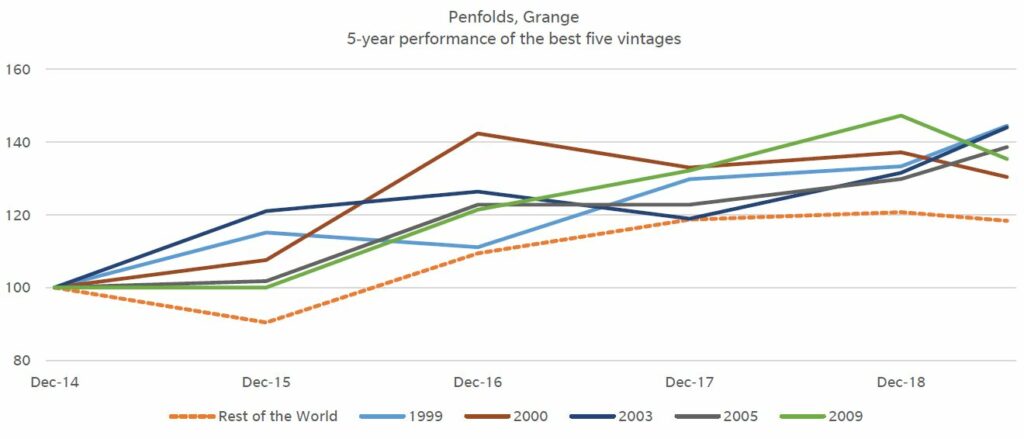

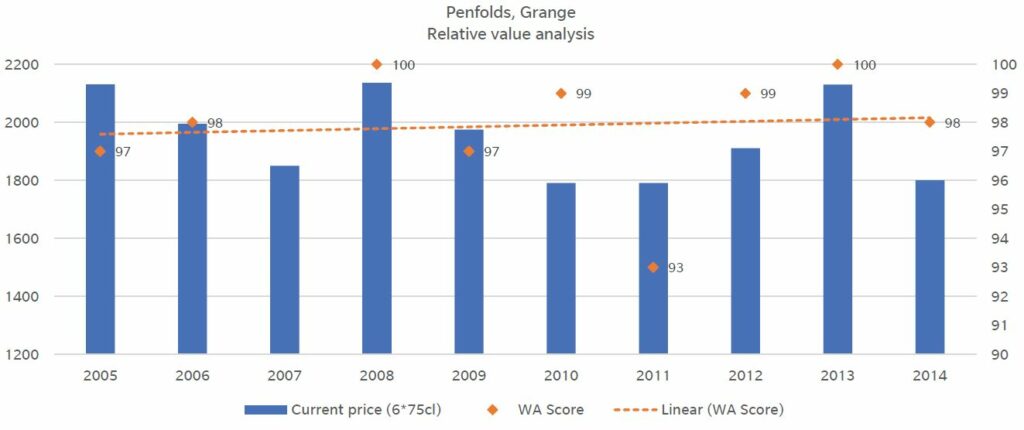

Tier One Producers in Emerging Wine Regions
Featured
- Mondavi & Chadwick, Sena – Chile
- Pingus – Spain
- Henschke, Hill of Grace – Australia
Mondavi & Chadwick, Sena
The Judgement of Paris, in 1976, catapulted Californian wine onto the international scene, making a name for top producers of Napa Cabernet. The lesser known Judgement of Berlin, in 2004, began the renaissance for its Chilean counterparts – lined up against Lafite, Latour and Chateau Margaux, both Vinedo Chadwick and Sena claimed the two top spots in the tasting.
Californian wine, over the last 10 years, has risen to represent some of the most expensive in the world, rivaling any of the greats from France. Chile is now poised to do the same, with Vinedo Chadwick, the top scorer in the Berlin tasting, now trading for over £200 per bottle. Looking beyond this, we bring you Sena, made by the same estate and a partnership between Eduardo Chadwick, the leading light in Chilean viticulture, and Robert Mondavi – arguably Napa’s biggest name, and the man who created Opus One in conjunction with the Rothschilds.
Unlike Chadwick, Sena is a far more modest third of the price, with recent vintages consistently receiving the same critic scores- we have isolated it as a pricing inconsistency which is primed to change. Labelled ‘Chile’s first ever icon wine’ by Decanter and credited with changing the landscape of the entire Chilean wine industry, it was the first to not only compete in quality with great Bordeaux, but also call it to light through this high-profile partnership.
With the first vintage created in 1995, the vineyard site was chosen to harness the cooling pacific breeze, in the same way as Napa Valley, to create a wine with finesse and freshness, whilst taking full advantage of the ripe Chilean sun. This is one of the ultimate representations of a wine on the rise. Producing a very ‘first growth’ esq 10,000 cases per year, the five most recent vintages of Sena have scored over 95 points as they tweak the formula. This new shift toward top scores from The Wine Advocate will inevitably lead to increased interest and price rises.
Market Performance
- Best performing 2004 vintage returned + 97%
- Average 5-year performance across vintage since 2000 + 41%
- Average WA scores of recent 10 vintages – 94 points
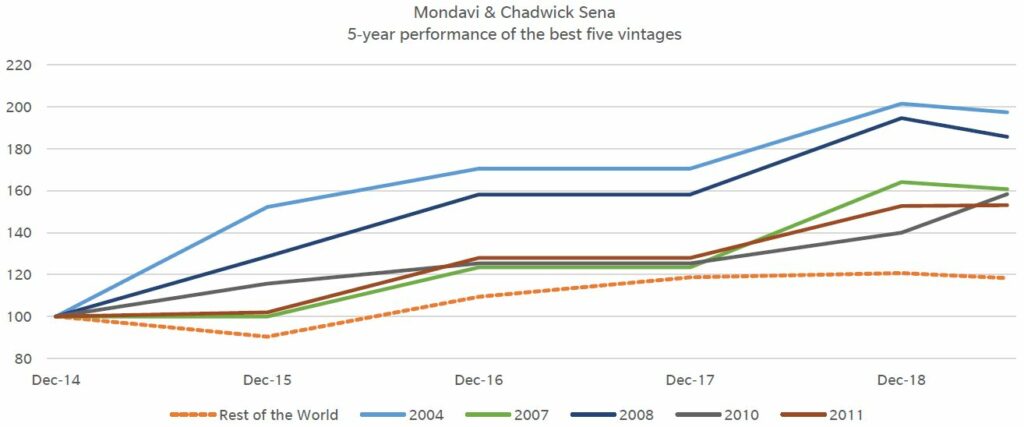

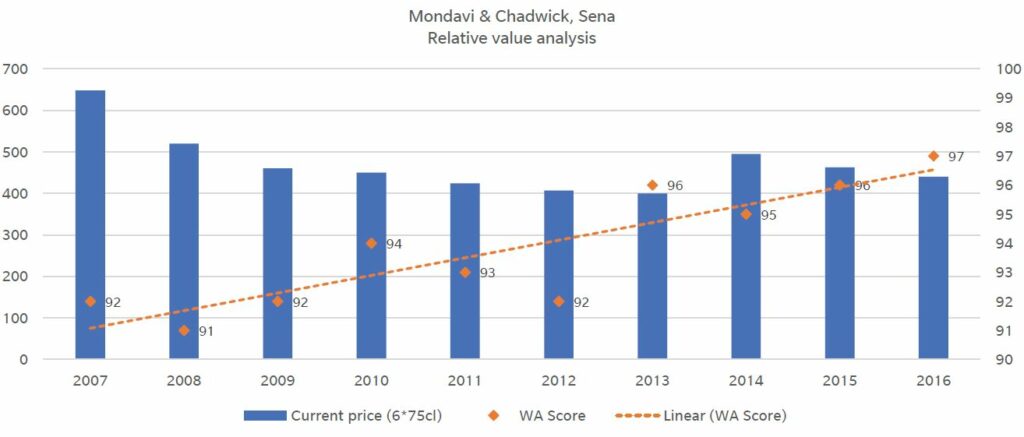

Pingus
Dominio de Pingus is a relative newcomer to the Spanish wine region of Ribero del Duero, having only been established in 1995 by Danish winemaker, Peter Sisseck. Sisseck’ was already involved in neighbouring Hacienda Monasterio; also known to produce highly rated wines. He still acts as their consultant to this day. Whilst developing Monasterio, he was already plotting his next move, and by 1995 he had identified a number of old vine parcels that would be the creation of Dominio de “Pingus” – named after his childhood nickname.
Often described as a visionary, his aim was to create the most singular and utterly unique “garagiste” style wine from ancient Tempranillo vines. Through contacts in Bordeaux he was fortunate enough to showcase his inaugural vintage at the 1996 En Primeur tastings, which in turn meant it came to the attention of Robert Parker of the Wine Advocate. It was not long after that the Wine Advocate bestowed a 100-point barrel score on the 1995 vintage with Parker describing it as one of the greatest red wines he had ever tasted!
“It is one of the greatest and most exciting young red wines I have ever tasted. I am not kidding when I say this might be the greatest young red wine I have ever tasted from Spain.” Robert Parker
Whilst other Spanish Wines have achieved international recognition; Pingus has, in its short life become a sensation; a truly Cult Wine by definition, rubbing shoulders with some of global icons of the wine world; such as Napa’s Screaming Eagle & Bordeaux’s Petrus & Le Pin. In terms of production, Pingus only produce only 500 cases per annum and yields are incredibly low at 12 hl per hectare.
Due to the meticulous strive for excellence, Pingus is not made in poor vintages; the last being 2002. Whilst all vintages score highly (they have three 100-point scores with the Wine Advocate) the 2004 is legendary with a market price of £17,500 per 12 compared to the average across all vintages of £6,500 per 12x75cl.
They also produce 4000 cases of their second wine, Flor de Pingus which is 100% Tempranillo and more recently another wine; PSI which is a collaboration between Peter and Pablo Rubio. This project is based on fruit produced by local growers from old vines to preserve the use of old vines and also help those that produce, but don’t bottle their grapes.
Market Performance
- Best performing 2004 vintage returned + 89%
- Average 5-year performance across vintage since 2000 + 24%
- Average WA scores of recent 10 vintages – 98 points
- 2012 and 2014 received 100 points awarded by Wine Advocate
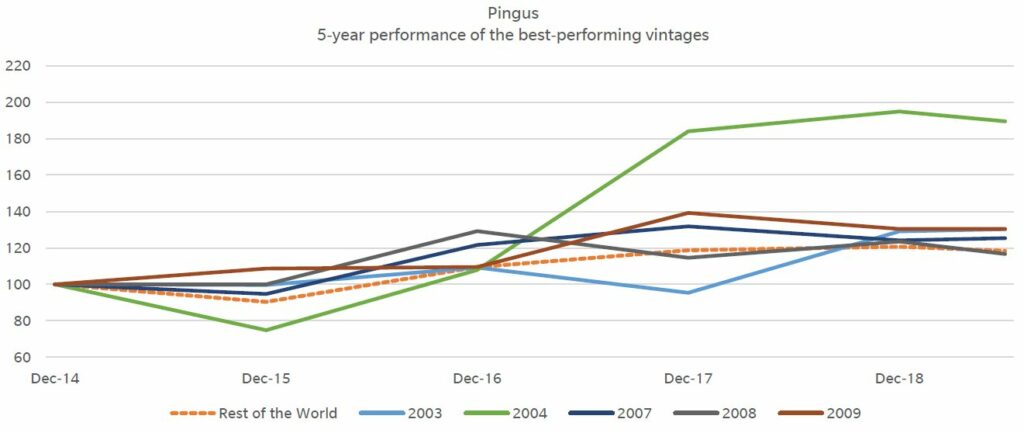

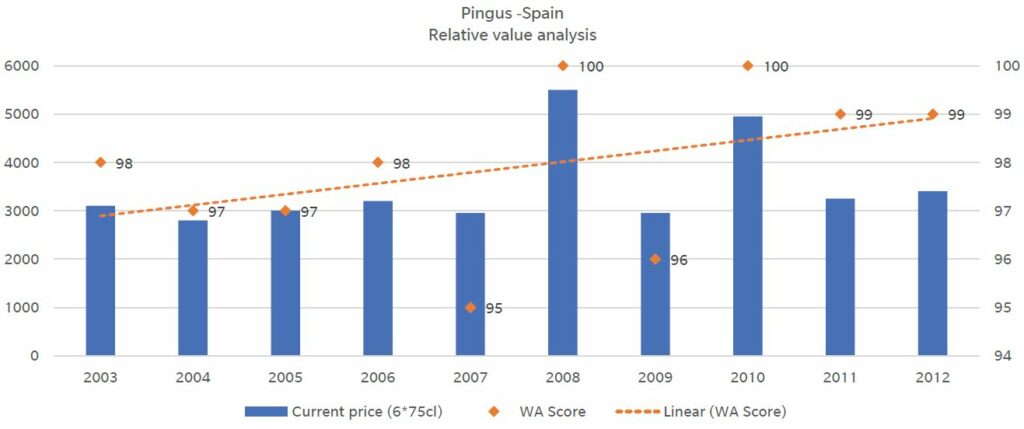

Henschke, Hill of Grace
When it comes to Australian wines, two big names come to mind – Penfolds Grange, and Henschke Hill of Grace. Livex recently published The Liv-ex Classification 2019, which is a league table that ranks the wines of the world by their average trade prices on their platform. Due to changing conditions of the market, this classification is updated every two years. These two Australian wines achieved a place in the 1st tier back in 2017 and have maintained their position.
Henschke’s flagship red, Hill of Grace was classified as “Exceptional”, the highest ranking in Langton’s Classification of Australian Wine in 2005 and is often praised as one of the best 100% Shiraz in the whole of Australia.
We would like to flag up Henschke from a brand perspective. All of Henschke’s wines perform well with critics. Hill of Grace is an undeniable stand-out, having won numerous awards, and commanding some of the highest prices in Australia. A more accessible avenue into the Henschke legacy is Mount Edelstone and Hill of Roses. Despite some fluctuation in prices have remained largely steady, although in this instance it seems age trumps critic scores – recent releases (barring 2014) have been nearly as highly acclaimed as its big brother, however release prices have also steadily risen. In this instance, collectors look beyond the short term to have their eyes on the inevitable value good cellaring will bring.
Market Performance
- Best performing 2008 vintage returned + 81%
- Average 5-year performance across vintage since 2000 + 39%
- Average WA scores of recent 10 vintages – 97 points
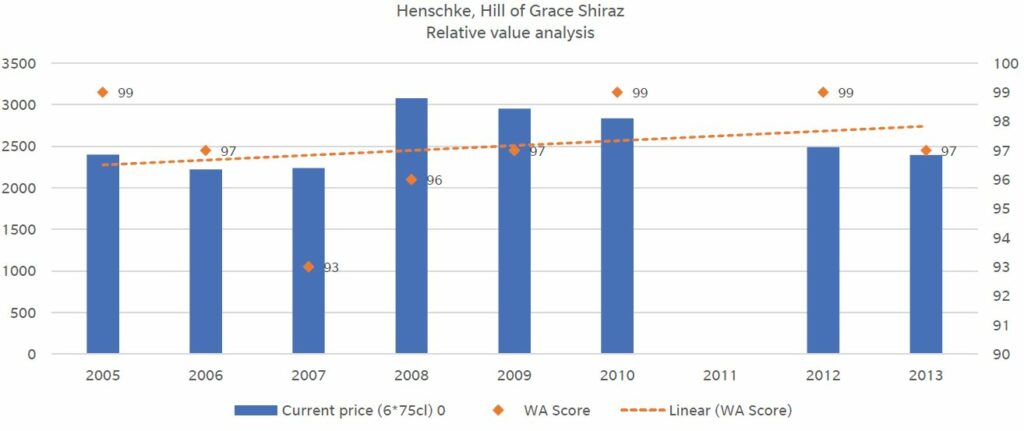

Rising Stars of US and Emerging Wine Regions
Featured
- Continuum, Propriety Red – US
- Clos Apalta – Chile
Continuum, Propriety Red
In 2004, Robert Mondavi Corp. of Oakville was sold to Constellation Brands for approximately $1.03 billion. The following year Robert Mondavi, his daughter Marcia Mondavi and his son Tim Mondavi, founded Continuum Estate. A wine has been released by the estate every year since 2005 however the first vintage to be released made up exclusively from vines grown on the estate was in 2012. Since then they have scored no less than 97 points each year from The Wine Advocate. A run of quality replicated from only a handful of vineyards globally in the same timeframe. It is for this reason and the fact that wine quality appears to only increase each year that the sub £1,000 per 6x75cl price tag is considered exceptionally modest.
Beyond the winemaking, the Mondavi family is a winemaking dynasty that is all too familiar with the processes required to develop a global wine brand and create demand in their product. This combination of honed business acumen and rarely paralleled winemaking skills serves as a potent mix when considering capacity for these wines to keep drawing attention, driving secondary market price appreciation. Production is extremely low, average output would be 3000 cases. High-yield vintages like the 2014 produced 4000 and 2000 cases in a low yield vintage like the
2015.
Continuum is certainly gaining considerable traction in the market already. Wine critic Lisa Perrotti-Brown scored the latest vintage, the 2016, 99 points and the resulting influx of demand drove price up by approximately 25%. Short term upside aside, medium to long term expectations from this estate are for prices to align with comparably scored wines from the Napa such as Opus One and Scarecrow which trade around £3000 – £5000 per 12x75cl.
Market Performance
- Best performing 2008 vintage returned + 65%
- Average 5-year performance across vintage since 2005 + 29%
- Average WA scores of recent 10 vintages – 96 points
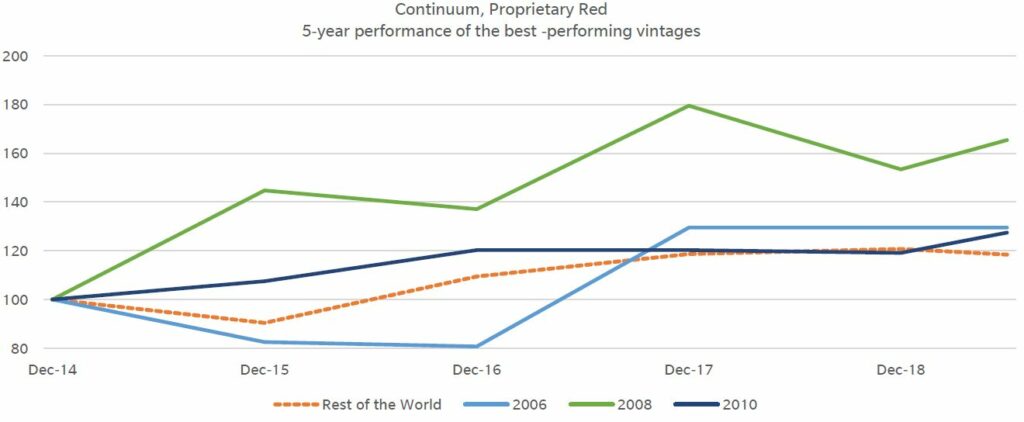

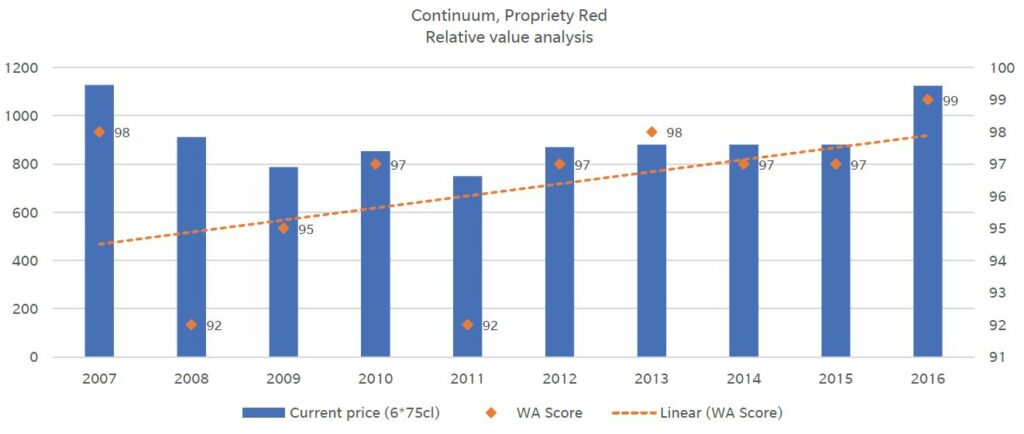

Clos Apalta
The ‘New World’ regions continue to provide outstanding value when stood against their European counterparts. Whilst these wines provide large amounts of historic data and scope for market analysis, it is key within wine, as with every other investment, to take immediate advantage of burgeoning trends. This is where the greatest gains can often be made. Clos Apalta, made by Chile’s Casa Lapostelle, is owned by the French family behind the Grand Marnier liqueur brand. They have combined an exceptional new world terroir with a decidedly French approach to winemaking. The vineyard was purchased in 1994, but with un-grafted vines over 100 years old, it is quite literally rooted in history.
Backed by the brand’s huge resources, this was the second Chilean wine ever to score the perfect 100 points by James Suckling; the most influential critic in South America. James Suckling on Clos Apalta; “Clos Apalta may be lesser known — in comparison to Bordeaux’s Château Lafite Rothschild, Tuscany’s Sassicaia or California’s Opus One — but it has been awarded perfect 100 points for both the 2014 and 2015 vintages. In hindsight, there’s no doubt that Clos Apalta is one of the world’s greatest red wines. Expressive and complex in flavour, both vintages are blessed with the balance and precision essential for 100 points.”
Market Performance
- Best performing 2010 vintage returned + 87%
- Average 5-year performance across vintage since 2001 + 49%
- Average WA scores of recent 10 vintages – 93 points
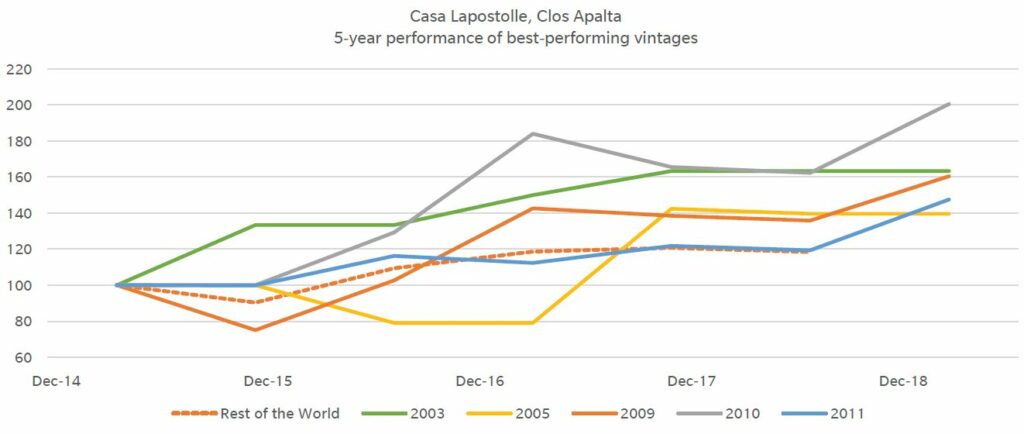

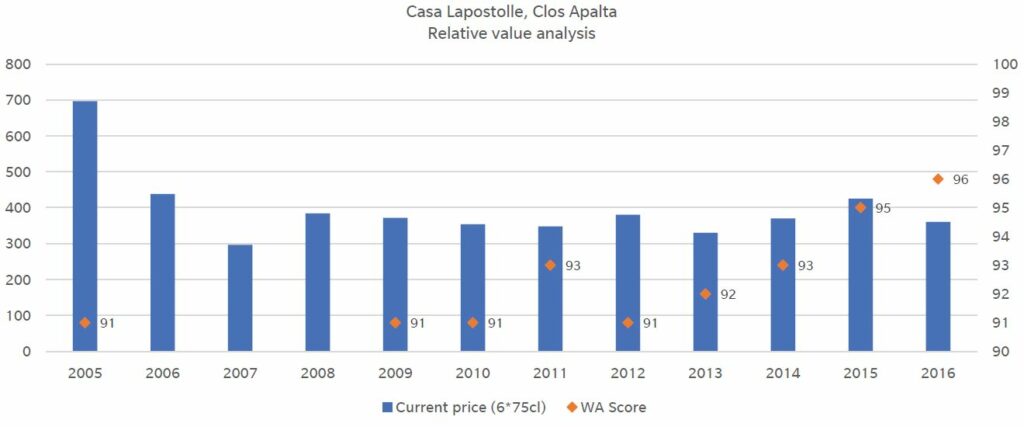

This expansion of the US and Emerging Market Report covers detailed views of Cult Wines recommended wines and producers, with historical performance and vintage comparison analytical views, this document will be a ‘must read’ for those looking to sink their teeth into the US and Emerging Markets as an investment opportunity.
